This report provides an in-depth analysis of the smart home industry, covering the development status, market size, policy support, competitive landscape of the industry chain, and future development trends. Below is a summary of the main content of the report in simple and understandable language:
Development History of Smart Homes
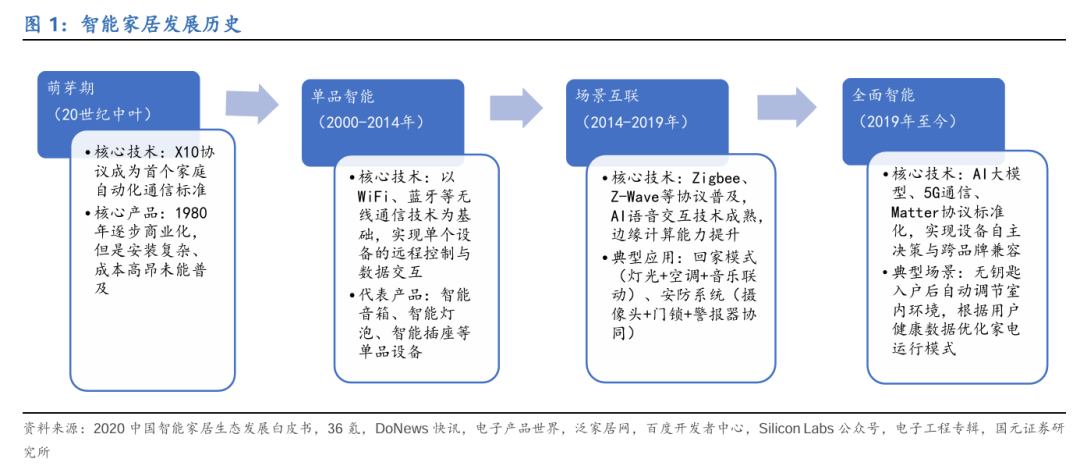
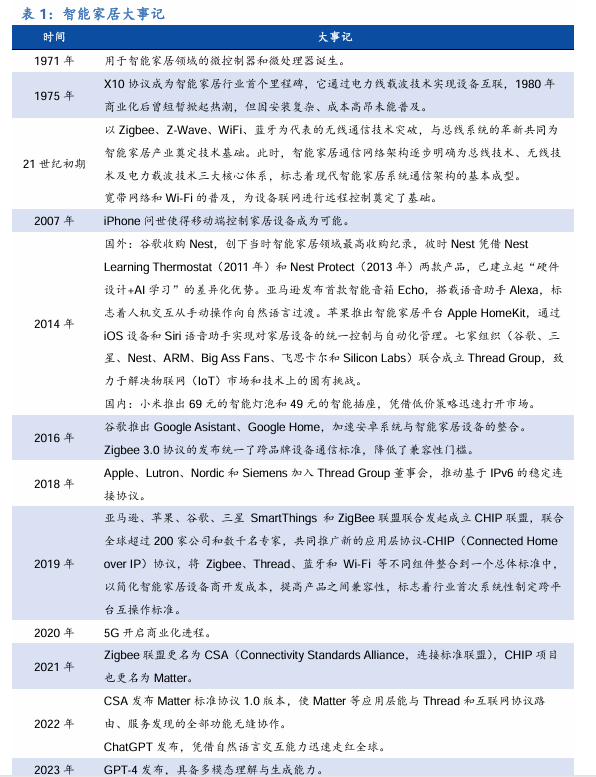
Early Stage: The concept of smart homes has existed for a long time. For example, the X10 protocol, which enables device interconnection through power line carrier technology, emerged in the mid-20th century. However, due to complex installation and high costs, it did not become widespread.
Single Product Smart Stage: From 2000 to 2013, with the development of wireless communication technology, single product devices such as smart speakers and smart bulbs emerged. These devices could be remotely controlled via mobile apps, but their functions were relatively independent.
Scene Interconnection Stage: From 2014 to 2019, internet and mobile companies began to build smart home platforms. Device manufacturers proposed the concept of “whole-house intelligence,” with smart speakers and smart locks becoming popular products. Devices began to interact, but compatibility issues were not fully resolved.
Comprehensive Intelligence Stage: From 2019 to the present, the development of technologies such as 5G and AIoT has propelled smart homes into a new era. Devices can not only communicate across brands but also learn user behavior patterns to autonomously formulate personalized scene strategies, achieving “proactive intelligence.”
Policy Support
Since 2020, various national departments have introduced a series of policies to support the development of smart homes, such as promoting technology standardization to enable interconnectivity between devices of different brands; encouraging the research and development of green smart products; promoting scenario-based integration; and implementing consumer incentive policies like trade-ins and subsidies to boost smart home consumption. Additionally, they are expanding the application scenarios of smart homes, such as smart communities and elderly-friendly renovations.
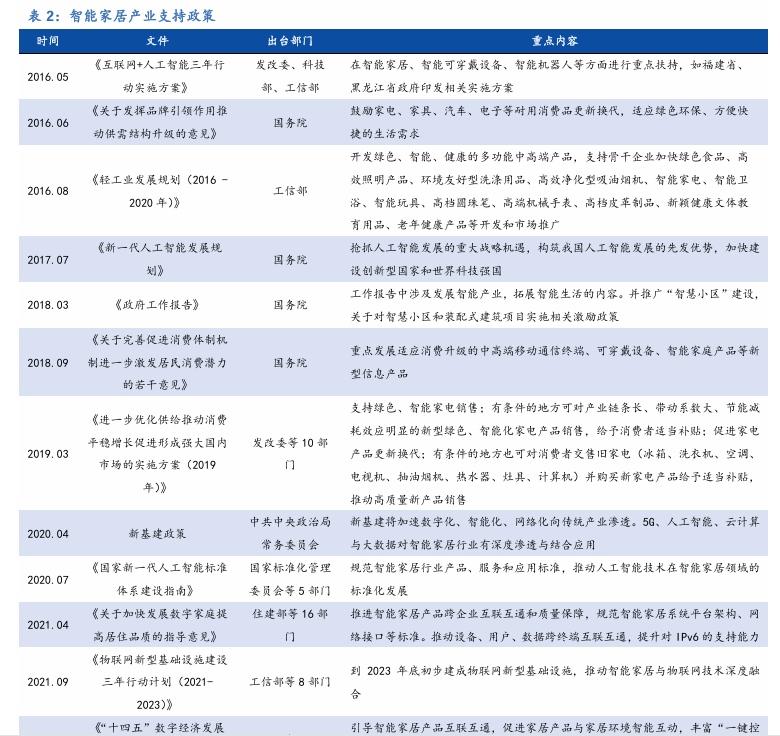
Market Size and Growth
In 2023, the market size of China’s smart home industry reached 755.81 billion yuan, with a compound annual growth rate of 13.68% from 2020 to 2023. In terms of segmentation, smart appliances and smart entertainment account for over 80% of the smart home market, with other segments including smart connectivity control, smart security, smart lighting, and smart energy management. Globally, the most active countries in the smart home sector are the United States, China, the United Kingdom, Japan, and Germany, with the Asia-Pacific region experiencing the fastest growth. China is expected to double its market size in the next 3-5 years.
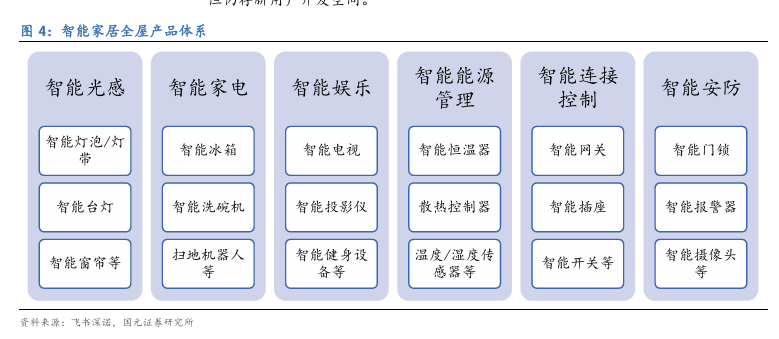
Competitive Landscape of the Industry Chain
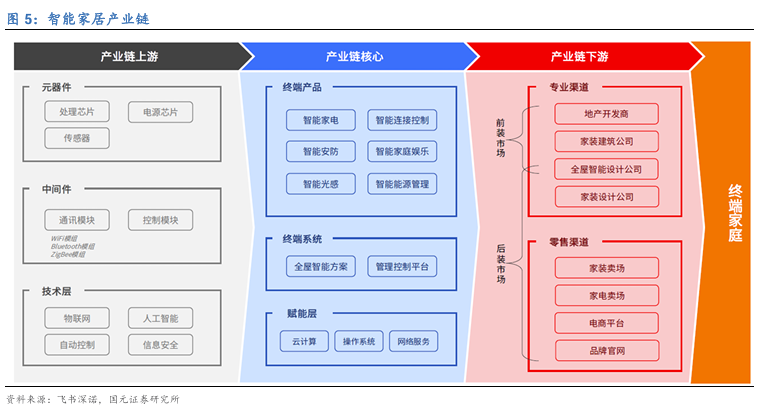
There are four main types of players in the smart home industry chain:
Full Ecosystem Smart Home Enterprises: Companies like Xiaomi, Huawei, and Ezviz, which have their own hardware products and platforms, focusing on whole-house smart solutions, covering all home scenarios and emphasizing their own ecological closed loop.
Single Product Hardware Enterprises: Companies like Ecovacs, Roborock, and XGIMI, which focus on specific fields, using technology-driven flagship products to open up markets, with leading single product performance and high flexibility.
Traditional Appliance Enterprises: Companies like Midea, Gree, and Haier, which leverage brand influence and channel resources to upgrade traditional appliances to smart versions and expand into whole-house products.
Internet Enterprises: Companies like Alibaba, JD.com, and Tencent, which focus on building platform ecosystems, integrating third-party hardware brands, expanding service scenarios, and leveraging user data insights and large-scale collaboration.
Future Development Trends
Technology-Driven: The development of technologies such as AI large models and 5G communication will further drive the revolution of smart home experiences, with more intelligent collaboration between devices and more proactive services.
Scene Expansion: The application scenarios of smart homes will continue to expand, extending from home scenarios to smart communities, elderly-friendly renovations, healthcare, and other fields.
Ecological Integration: The interconnectivity between devices of different brands and categories will become smoother, forming a more complete smart home ecosystem.
👇Scan the code to join the community, access the full report, and unlock unlimited downloads of 49 industries and over 2100 reports, with daily updates to keep you at the forefront of market trends!(Report Directory: https://docs.qq.com/sheet/DQUNSS3JZanByRmFh) [The reports published by the public account are collected and organized from publicly available internet resources for learning and communication purposes only, and may not be used for other commercial purposes. Copyright belongs to the author. If there is any infringement, please contact us for resolution.]
[The reports published by the public account are collected and organized from publicly available internet resources for learning and communication purposes only, and may not be used for other commercial purposes. Copyright belongs to the author. If there is any infringement, please contact us for resolution.]
Additionally, IKEA has released the “2024 Home Living Report,” which mainly explores the importance of home in people’s lives and how to enhance happiness and joy in family life through simple means. Below are the main contents, and if you are interested in the original text, there is a free download link at the end.
1. The Importance of Home
Happiness and Belonging: Home is an important place for people to gain happiness and a sense of belonging. The report points out that home not only provides a refuge but also helps people find joy in daily life.
The Importance of Joy: Research shows that those who feel happy at home are more satisfied with life and more optimistic about the future.
2. Enjoying the Joy of Home
The Importance of Enjoyment: Enjoyment is an important part of a good family life, but the report finds that over one-third of people globally believe enjoyment is important yet often cannot find satisfaction at home.
Ways to Enjoy: The report lists some common ways to enjoy, such as hugging family members, spending time on personal hobbies, laughing with those around you, spending time alone, and enjoying a home-cooked meal.
3. Enjoyment Methods in Different Countries
National Characteristics: The report also analyzes the different ways people enjoy themselves at home in different countries. For example, Americans prefer spending time with pets, Indians enjoy playing with children, while Singaporeans enjoy cooking large family meals.
Cultural Differences: These differences reflect the varying pursuits of happiness among people from different cultural backgrounds.
4. How to Enhance Happiness in Family Life
Health and Happiness: The report emphasizes that health and happiness are important components of family life. By maintaining good mental and physical health, people can better enjoy family life.
Personalized Space: The report suggests that personalizing home spaces, such as adding favorite decorations and improving living environments, can enhance the sense of belonging and happiness at home.
Building Connections: Establishing connections with family, friends, and the community to share good times is also an important way to enhance family happiness.
5. Future Trends and Recommendations
Flexible Living: As work and lifestyle change, homes need to be more flexible to adapt to different living needs.
The Role of Technology: The report also discusses how technology can help people better enjoy family life, such as smart home technology enhancing convenience and comfort in life.
Community and Environment: The report points out that community and natural environments also significantly impact happiness in family life, suggesting that people participate more in community activities and interact with nature.
6. Conclusion
The Return of Joy: The report concludes by emphasizing that joy is an important part of family life, and through some simple yet meaningful changes, people can bring more joy back home.
A Continuous Journey: Improving family life is an ongoing process that requires continuous exploration and practice.
Download link: https://pan.baidu.com/s/1iEXYZz8OifqsxgXiKApP6Q?pwd=59dk